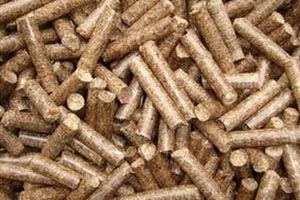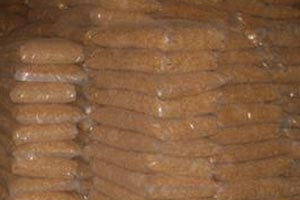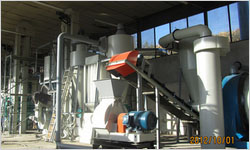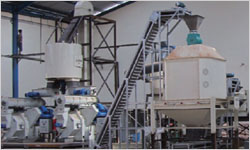Pellet fuel market in EU
Biomass pellet market has been developed for many decades. The dominating market of biomass pellet fuel goes to the Europe and North America. EU is known to be the biggest wood pellet producer all over the world. Although the pellet plants in EU are in small or medium scale compared with pellet plant in North America, however, most of the main pellet producing countries have a considerable demand for wood pellet, which is used for domestic heating production. The increasing demand for wood pellets has promoted the development of the pellet plant in return.
New pellet plant projects were announced in the US, with almost 1,5 million tons of pellets produced to be shipped in Europe in the next years. UK started to construct two pellet plants, one is located in Louisiana and the other in Mississippi with a joint capacity of 900,000 tons per year. Also a pellet plant in Canada has already started pellet production in August, the production of which will reach 120,000 tons per year.
The EU countries are the biggest pellet fuel consumers in the world, and they are also the primary region for production of pellet fuel. The production accounts for 50% of the global consumption, the production for consumption account for almost 70% of the global market. In 2013, the amount of consumption in EU is 175 million ton, and it has become the biggest sawdust pellet consumption market in the world.


Read:How to make wood pellets
On the one hand, in Europe there is lack of wood, so wood is more and more expensive material for pellets. Major power plants and residential consumers in North America, Europe and Asia are turning to wood pellets as an alternative to fuel oil, gas or electricity to heat homes. Wood pellets, made from waste wood such as wood shavings and sawdust, are carbon neutral and do not contribute to global warming because they emit the lowest greenhouses gases of any fuel burned. The U.S. Environmental Protection Agency has endorsed wood pellet heat as one of the cleanest burning, most renewable energy sources on the planet. Global wood pellet production in 2008 was almost 11 million tons, and some analysts believe worldwide production could double by 2014.
In 2008, industrial production of electricity from wood amounted to 10.9 billion kilowatt hours. The figures tell us that wood as a feedstock for electricity production is growing exponentially right now.
It looks like it is going to have a huge market for low grade wood and agro products for biomass. The demand for biomass is going to quadruple from 2009 levels to 2014.
There is a huge number of facilities that either are being constructed or will be constructed, and when completed they are going to demand 125 million tons of wood a year, and that’s quite an astounding number. The demand for pellet plant continues to expand. There is going to be lots of market for what we cal waste. And maybe waste is the wrong term. Because of all the material have a lot of good value. In the U.S. the renewable energy market is more than 50% of green energy that is produced. And it amounts to more than 1/3 of our total energy supply.


In EU, the market of sawdust pellet fuel is mainly classified into two parts: industrial application and residential use. Actually, the pellet for residential use is increasing. Among the EU countries, United Kingdom, Italy, Denmark, German and Swiss are all on the top of pellet consumption countries.
Except the sawdust pellet, a large amount of wood bark or low grade wood is also be used in the pellet plant. And the demand for that in the world is about 145 million tons each year. It is expected that the figure is going to rise to 280 million tons. The North Europe is the market with great potential.
According to the Union of EU sawdust pellet, the demand for heat system in EU increases 15% each year during the past three year. In addition, the sales of pellet stove and fireplace are increase significantly in German, Italy and France, and it may cause the increasing of pellet consumption in EU further. In Swiss and Denmark, the application of pellet fuel is much more versatile, which includes family pellet stove, medium scale power plant by pellet fuel and large scale power generation. The aim of renewable energy account for about 49% and 35% of the total energy consumption separately. Even several large scale pellet plants have been built or still in construction, the demand for pellet fuel is still increasing.
In England and Holland, the sawdust pellets are mainly used for the large scale power generation. In recent years, the government has given policy subsidy to the development of pellet fuel and pellet plant according to the goal of EU. Due to the restriction of these countries, it mainly depends on the import of sawdust to meet the demand of biomass energy.
------------------------------------------------------------------------------------------------------------------------------------------------------
Across the Republic of Korea, biomass material actually refers mainly to residues from wood processing industry. The (presumably) only large-scale wood pellet plant is situated at the National Forestry Cooperatives Federation Wood Products Distribution Centre. The raw material used is saw dust supplied by the adjacent woodworking operation.
News
- Small Pellet Machine Manufacturer-Kingman
- Application of Wood Pellets and Use of Biomass Pellets
- From Fossil Fuel into Biomass Pellet Fuel
- Biomass Pellet Making Machines Market
- Applying of pellet stoves for home use
- Highland pellets to build $130 million facility in arkansas
- How to deal with the blocked hammer mill
- How to Make Wood Pellets with Sawdust
- The government policy promotes the development of biomass fuel
- Market analysis of biomass pellet fuel
- Strategic positioning of renewable energy
- Biomass energy has pass through the pre assessment
- The key point of deep processing of biomass pellet
- Harbin is promoting the development of biomass machinery
- The development of biomass formation technology I
- The development of biomass formation technology II
- Biomass energy industry is now going full tilt in 2015
- Rapid increasing demand of sawdust pellet on the market
- Pellet fuel market in EU
- Chinese Biomass Energy Conference held in Beijing
- Future market development of straw pellet mill
- Peanut Shell Pellet Mill Makes High Quality Pellets
- The utilization of straw is only 5%, biomass energy needs our attention!
- Corn straw pellet machine relieves the tight supply of fuel energy
- Reasons for loose or not forming of biomass pellet mill





